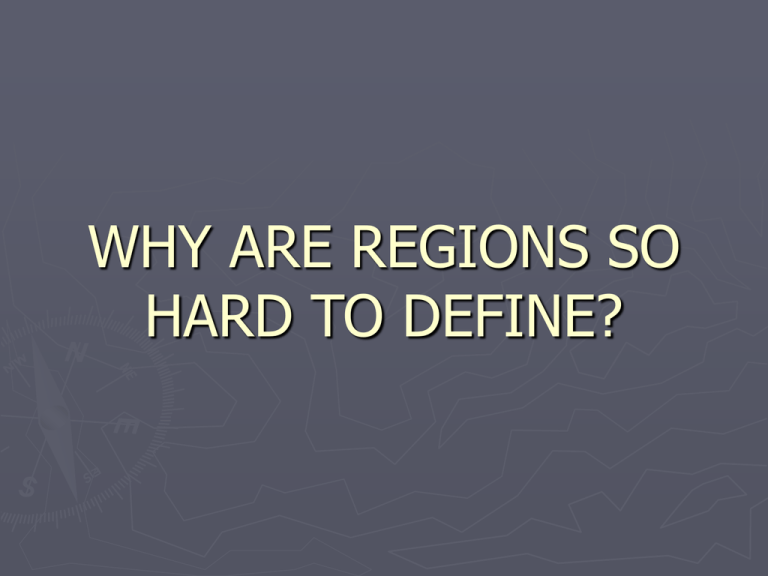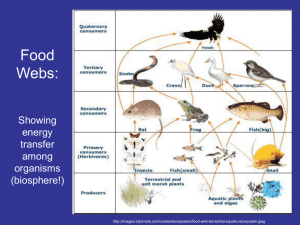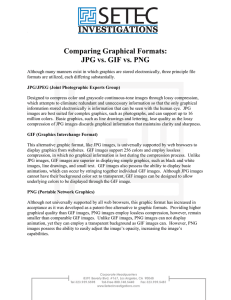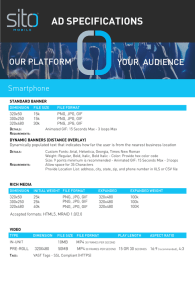Defining Regions: Geography Presentation
advertisement

WHY ARE REGIONS SO HARD TO DEFINE? First, Regions are about SCALE Global Scale http://www.funpartystores.com/images/wbd_world-map.jpg National Scale http://apps3.eere.energy.gov/greenpower/images/map_us.gif State and County Scale http://www.touristguide.com/maps/arkansas-map.jpg http://www.e-referencedesk.com/resources/counties/images/arkansas-county-map.gif Wards, Precincts, Census Tracts What is a Region? A region is an area with one or more traits, characteristics, features that are common and make it different from surrounding areas. What regional maps are these? The College Board® by Region http://www.collegeboard.com/prod_images/about/association/cbregion.gif The Southeastern Conference http://billsportsmaps.com/wp-content/uploads/2007/11/sec3.gif The WAC members http://upload.wikimedia.org/wikipedia/commons/8/83/WAC-USA-states.PNG The “Fed” has regions http://midnight.hushedcasket.com/wp-content/uploads/2009/01/federal_reserve_districts_map.png Another region http://orgs.unt.edu/geography/Images/swaag.logo With special thanks to Debbie Lange Regions are defined by their physical and human characteristics There are 3 types of regions FORMAL REGION http://www.nationalgeographic.com/xpeditions/standards/05/index.html ► ► ► ► ► ► ► Also known as a uniform region It is characterized by a common human property, such as the presence of people who share a particular language, religion, nationality, political identity or culture, or by a common physical property, such as the presence of a particular type of climate, landform, or vegetation. Political entities such as counties, states, countries, and provinces are formal regions because they are defined by a common political identity. Other formal regions include climate regions (e.g., Mediterranean) Landform regions (e.g., Piedmont region of Pennsylvania) Economic regions (e.g., wheat belt of Kansas) Formal regions can be defined by measures of population, per capita income, ethnic background, crop production, population density and distribution, or industrial production, or by mapping physical characteristics such as temperature, rainfall, growing season Germany is formal region http://harryallen.info/wp-content/uploads/2008/04/germany_map.jpg Corn Production (and Ethanol Plants) http://www.dailyyonder.com/files/imagecache/story_default/imagefield/cornp-production-and-ethano.jpg Piedmont Region of Pennsylvania http://upload.wikimedia.org/wikipedia/en/6/60/Map_of_PA_Highlands.gif FUNCTIONAL REGIONS http://www.nationalgeographic.com/xpeditions/standards/05/index.html Organized around a node or focal point with the surrounding areas linked to that node by transportation systems, communication systems, or other economic association involving such activities as manufacturing and retail trading. ► A typical functional region is a metropolitan area (MA) as defined by the Bureau of Census. For example, the New York MA is a functional region that covers parts of several states. It is linked by commuting patterns, trade flows, television and radio broadcasts, newspapers, travel for recreation and entertainment. ► Other functional regions include shopping regions centered on malls or supermarkets, area served by branch banks, and ports and their hinterlands. ► A less formal look at functional regions ► Defined by a set of activities, connections or interactions ► For example: ► Newspaper circulation area ► Commuter traffic patterns ► Subway systems in NYC, Boston, etc. ► Highway systems NYC Subway – a functional region http://www.johnsonbanks.co.uk/up_images/228_MTA_current_400.jpg Perceptual Region http://www.nationalgeographic.com/xpeditions/standards/05/index.html ► ► ► Construct that reflects human feelings and attitudes about areas and is therefore defined by people’s shared subjective images of those areas Tends to reflect the element of people’s mental maps, and, although it may help to impose a personal sense of order and structure on the world, it often does so on the basis of stereotypes that may be inappropriate or incorrect. Examples such as: Southern California, Dixie, and the upper Midwest are perceptual regions that are thought of as being spatial units, although they do not have precise borders or even commonly accepted regional characteristics and names. Just where is Dixie? http://upload.wikimedia.org/wikipedia/commons/a/a3/US_map-The_South_Modern_.png Gotta do the Zelinsky Debbie gave me this map, too… Perceptual, maybe – but how could this region be formalized? http://cartophilia.com/blog/uploaded_images/nikeucob-713437.jpg Let’s do a couple of activities you can do with your students ► In one color draw a line around what you think is, “THE SOUTH” ► In another color draw a line around, “THE MIDWEST” ► In yet another color, draw a line around, “THE NORTHEAST” ► What about “THE SOUTHWEST”











